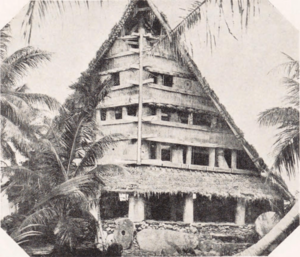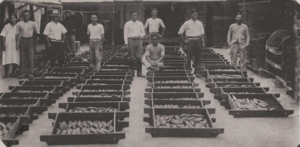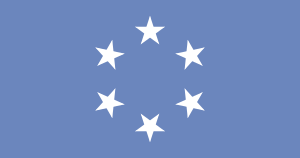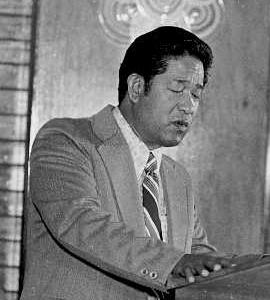History of the Federated States of Micronesia facts for kids

The Federated States of Micronesia are a group of islands in the western Pacific Ocean. Their history includes settlement by Micronesian people. Later, the islands were taken over by Spain, Germany, and Japan. After World War II, the United Nations put the islands under the care of the United States as the Trust Territory of the Pacific Islands. The Federated States of Micronesia slowly gained independence, starting with their own constitution in 1979.
Contents
Ancient History of Micronesia
The ancestors of the Micronesians, who were Austronesian people, settled these islands over 4,000 years ago. At first, they had a system where different chiefs ruled small areas. Over time, a more organized culture developed on Pohnpei, focusing on economy and religion. People from the Caroline Islands often visited the Chamorro people on the Marianas Islands. They also sometimes traveled to the eastern islands of the Philippines.
The Yapese Empire
Yap's Unique Relationships
Around 1500 BC, long before European countries arrived, the island of Yap had a special way of connecting with nearby islands to its east and southwest. This was known as the Yapese Empire. It wasn't a huge, formal empire, but a network of trade and politics. The village of Gatchaper in Gagil Municipality led this network. It covered about 1,500 kilometers (932 miles) of the western Pacific, reaching islands between Yap and Chuuk.
This relationship was called sawey. The Yapese Empire asked for gifts, known as Pitigil Tamol, for the main chief of Gagil. These gifts included things like `bagiiy` (a type of cloth), coconut rope, coconut oil, mats, and shells. In return, Gagil would help the smaller islands if there were natural disasters. They also provided goods like Yapese canoes, turmeric, and flint stone. People with good navigation skills also helped out. This system might have helped the Yapese sail to Palau to get Rai stones. These large stone disks, carved from calcite, are still used today for important cultural exchanges.
Even though this system might seem like Yap was taking advantage of the outer islands, many researchers believe it was mostly fair. They think it often helped the Carolinian islands more than the Yapese. Some even suggest the "empire" started through conquest or using sorcery and economic power.
Another similar system in the Pacific was the Tongan Empire, which is now the Kingdom of Tonga.
Yapese Society and Social Classes
Before foreign countries took over, Yapese society was divided into many villages and areas. It was very much like a feudal system. Power was not held by one ruler but was shared among at least ten different areas. A key part of Yapese society was its unique and complex social class system, which is still used today. Each of Yap's 129 villages has its own class ranking.
| HIGH CLASSES: TABUGUL ("PURE") | |
| CLASSES/CASTES | |
| Bulche'/ 'Ulun | Chiefs |
| Methibaan/Tethibaan | Nobles |
| Daworchig | Commoners |
| LOW CLASSES: TA'AY ("IMPURE") | |
| CLASSES/CASTES | |
| Milingaay ni 'Arow | Servants |
| Milingaay | Serfs |
| Yagug/Milignaay ni Kaan | Serfs |
Each village had its own class rank based on how many military battles it had won. Inside each village, there were also different social classes. Lower classes and villages were under the control of higher-ranked villages, which had a lot of power and influence (called lungun). Gatchaper, mentioned earlier, is an example of a high-ranking village, called Bulche' or 'UIun. Because villages were often fighting, their social ranks would change depending on who won the battles.
However, when Germany took control of Yap in the 20th century, they stopped all violent conflicts. This meant that the social class rankings became fixed and could no longer change. Today, there are three main high-ranking chief villages: Teb Village in Tamil Municipality, Ngolog Village in Rull Municipality, and Gatchaper in Gagil Municipality.
These chief villages are called "fare dalip e nguchol" in Yapese, which means "the three cooking stones." This saying describes the relationship between these three villages and the other seven. The stones represent Tamil, Gagil, and Rull, while the pot represents the island of Yap. The saying means that if one of these important villages or areas fell, all of Yap would suffer.
Pohnpei and Saudeleur Rule
Pohnpei's Ancient Rulers

On Pohnpei, ancient history is split into three main periods. The first was Mwehin Kawa or Mwehin Aramas (the Period of Building or Peopling), before about 1100 AD. Then came Mwehin Sau Deleur (the Period of the Lord of Deleur), from about 1100 to 1628. Finally, there was Mwehin Nahnmwarki (the Period of the Nahnmwarki), from about 1628 to 1885.
Pohnpeian stories say that the Saudeleur rulers, who first brought government to Pohnpei, came from another land. These rulers had total power, but over many generations, their rule became very harsh. They made unfair demands and were said to offend the Pohnpeian gods. This made the Pohnpeians very angry. The Saudeleur Dynasty ended when Isokelekel, another person from outside the island, invaded. He replaced the Saudeleur rule with the more spread-out nahnmwarki system, which is still used today. Isokelekel is seen as the founder of the modern Pohnpeian nahnmwarki social system and the father of the Pohnpeian people.

Nan Madol: The Pacific's Venice
Nan Madol, located off Temwen Island near Pohnpei, is a group of small artificial islands connected by canals. It's often called the Venice of the Pacific. This was the main place for ceremonies and politics for the Saudeleur Dynasty. This dynasty united Pohnpei's estimated 25,000 people. However, their central system fell apart when Isokelekel invaded. Isokelekel and his family first lived in the stone city but later left it.
European Colonization
Arrival of Europeans
European explorers arrived in the Caroline Islands in the 16th century. First came the Portuguese, who were looking for the Spice Islands (in Indonesia). Then came the Spanish, who eventually claimed control over the islands.
In 1899, Spain sold the islands to Germany as part of a treaty. Germany then placed them under the control of German New Guinea. German efforts to change the traditional social order and force people to work on construction projects led to a rebellion by people in Sokehs Municipality in 1910.
Before World War I, Yap was an important German naval communication center. It was also a key international hub for telegraph cables. In September 1914, Japanese troops took over Yap. After the war, in 1919, the League of Nations gave Yap to the Japanese Empire as a mandated territory under the Versailles Treaty. The United States also made a special treaty with Japan on February 11, 1922, to protect its business rights on the island.
Japanese Rule
During World War I, Japan fought alongside the Allies of World War I. They took control of many German territories in the Pacific.
From 1920, the Empire of Japan managed the islands under the South Seas Mandate given by the League of Nations. During this time, the Japanese population in Micronesia grew to over 100,000, while the local population was about 40,000. Key industries included sugar cane, mining, fishing, and tropical farming.
World War II in Micronesia
In World War II, the U.S. used a "leapfrogging" strategy, meaning they skipped over some Japanese-held islands like Yap. However, Yap was still bombed regularly by U.S. ships and planes. Japanese bombers based on Yap also caused some damage in return. The Japanese military group on Yap included 4,423 Imperial Japanese Army soldiers and 1,494 Imperial Japanese Navy sailors.
A large part of the Japanese fleet was based in Truk Lagoon. In February 1944, Operation Hailstone, one of the most important naval battles of the war, happened at Truk. Many Japanese supply ships and aircraft were destroyed there. World War II brought a sudden end to the good times the islands had experienced under Japanese civilian rule.
Becoming a Trust Territory
In 1947, the United Nations created the Trust Territory of the Pacific Islands (TTPI). This territory included Pohnpei (which then included Kusaie), Truk, Yap, Palau, the Marshall Islands, and the Northern Mariana Islands. The United States agreed to be the Trustee, meaning they would manage the territory. This was a special "Security Trusteeship," and its future would be decided by the UN Security Council. As Trustee, the U.S. was supposed to help the people become economically strong and self-sufficient.
Independence for the FSM
On May 10, 1979, four of the Trust Territory districts approved the Constitution of the Federated States of Micronesia. The nearby districts of Palau, the Marshall Islands, and the Northern Mariana Islands chose not to join. The Honorable Tosiwo Nakayama, who was the former President of the Congress of Micronesia, became the first President of the FSM.
The FSM signed a Compact of Free Association with the U.S. This agreement officially started on November 3, 1986, marking Micronesia's move from being a trust territory to an independent nation. Under this Compact, the U.S. is fully responsible for the defense of the FSM. This security agreement can be changed or ended if both sides agree. The Compact also provides money and federal program help from the U.S. to the FSM. New financial agreements began in 2004. The basic relationship of free association continues for a very long time.
The United Nations ended the trusteeship of the islands with United Nations Security Council Resolution 683, passed on December 22, 1990. The Compact was renewed in 2004.
See also
 In Spanish: Historia de los Estados Federados de Micronesia para niños
In Spanish: Historia de los Estados Federados de Micronesia para niños
- History of Oceania
- President of the Federated States of Micronesia
- Vice President of the Federated States of Micronesia
- Politics of the Federated States of Micronesia
- Yap







